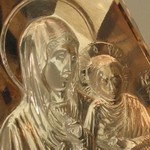 Vintage, antiques, retromixture of the Victorian style and the style of the moderne epoch - today we with pleasure recollect all that was "perfectly well" forgotten by us many years ago. After several decades of total domination of "techno" and emasculated minimalism we have every reason to afford a weakness of possession of the bagatelles which came to us from the far past. Pleasure is more flattering, the more ancient the knickknack of possession is or the longer its history is. Together with art-deco furniture, juis fabrics, corsets, the Victorian black amber and lacy mitts cameos also come back, and not only as antiquarian curiosities, but also as the magnum opuses of today. Vintage, antiques, retromixture of the Victorian style and the style of the moderne epoch - today we with pleasure recollect all that was "perfectly well" forgotten by us many years ago. After several decades of total domination of "techno" and emasculated minimalism we have every reason to afford a weakness of possession of the bagatelles which came to us from the far past. Pleasure is more flattering, the more ancient the knickknack of possession is or the longer its history is. Together with art-deco furniture, juis fabrics, corsets, the Victorian black amber and lacy mitts cameos also come back, and not only as antiquarian curiosities, but also as the magnum opuses of today.
Agree that there is no the best filter and no more strict judge than the time. Presumably that is why the glyptics (the art of grooving on a stone), which appeared in the Akkadian times and adequately survived social - art metamorphosises of several millennia, causes true admiration not only of critics - judges of cameos and intaglios.
To Russia gemmas came from Byzantium together with the acceptance of Christianity, having had time by then to die and to be born several times. The fact that stone miniatures in Russia started to be made in epoch of adoption of Christianity was surely reflected in plots of the ancient Russian cameos. There started to cut the Christ, the Virgin and Saints out of a bone, limestone, slates, sandstone, and these icons were worn next to the skin as guards due to which they had got the name of collar icons. By the XVI century the tradition died away. And only in the XVIII century cameos again reminded of themselves. Thanks to Ekaterina the Great, the Mother, who in-between of the state duties and personal entertainments collected antique cameos, and it must be said that her collection was excellent.
The last animation of rush to stone miniatures fell at the moderne with its passion to all refined - pretentious. Perhaps the today's confident return of cameo to the positions of bohemian favorite, which also by the way falls at the brink of centuries, might be considered predictable to some extent.
The architect from Dnepropetrovsk Svyatoslav Nikitenko hardly expected that his enthusiasm for cameos with which he "was taken ill" 8 years ago today would have come in handy thus much. Today an anaglyphy on the most expensive, firm and complex rocks is definitely the business of all his life, and all that began with Zodiac Taurus turned of wood for his wife's birthday.
On the second course of the Architectural Institute Svyatoslav Nikitenko realized that he was far more successful at modelled images than at drawn ones, and in 1993, when he reasonably answered with consent to the request of his brother to emboss a pair of bone cameos, understood that he had found not only a profession but also and himself. During 8 years of work he created more than 250 cameos, mainly on religious topics, a number of masterpieces of which constitute the immense-in-handicraft-skill collection of the modern Russian glyptics, continuing the ancient subplot traditions on the material actually not used in Russia before. The master had an opportunity to work even with corundum which does not yield in density to diamond.
Nikitenko loves transparent stones and this love in times complicates the working process - it is much more difficult to see the form, the more so that the light directed to the stone reflects a beam into your eye. Nevertheless his favorite is a cornelian. Problems with an uneasy material abandon when the case comes to the tools, the majority of which the master manufactures himself. In reply to the fair amazement Nikitenko answers: "Anaglyphy is only 20% of work, the image is born and formed in mind". Last year the cameo "Crucifixion" ( topaz with dimensions 6,6 x 3,4) embossed by Nikitenko was presented to the Patriarch of the Lebanese Orthodox Church, some more of his cameos enrich private collections in Europe - the stone miniature is still considered a magnificent gift and rather successful investment.
The corny phrase that the art is eternal, in this case fully justifies itself.
The fact that the glyptics is in favor again is confirmed by the appearance of the demand on cameos alongside with the supply. To start with that in Italy this tradition did never die and till the present day there are Embossing Schools, and at the largest world auctions during the recent few years a number of cameos were put forward and were constantly prosperous.
The last year in Moscow in the Museum named after A. S. Pushkin within the framework of the program "Guest-Night in the Russian Manor", dated for the 40th anniversary of the Museum, there rather successfully passed the exhibition presented by the gallery "My Collection" where works by Svyatoslav Nikitenko were exhibited.
The success of this action and the increased interest to cameos as a whole give confidence that the personal exhibition of Svyatoslav Nikitenko scheduled for the next year will be not less successful.
|